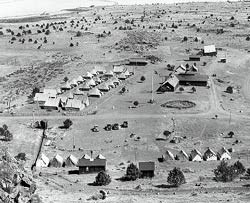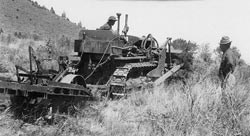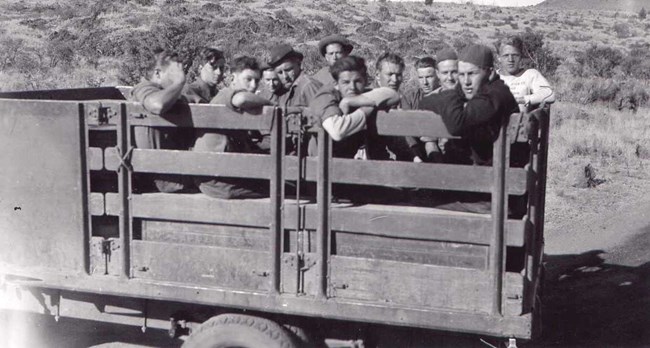
Gillems Camp, one of the principal military encampments of the Modoc War of 1872-73, came to life again under very different circumstances sixty years after the army left the lava beds. The old campsite became the center of Camp Tulelake, a base for a succession of Civilian Conservation Corps (CCC) crews that would transform the newly established national monument. The CCC was a very successful relief program during the Great Depression. In an effort to alleviate unemployment while making needed improvements to public lands, President Franklin Roosevelt’s administration started the CCC in 1933. Men enlisted for six-month tours of duty, and most re-enrolled for a full two years. Up to 150 young men were formed into work crews under Army supervision. The CCC swiftly constructed thousands of camps all over the country, including hundreds in neglected or newly established western national park sites. Among the tasks assigned to these crews were road and trail building, firefighting, the installation of electric and telephone lines, and the construction of park administrative and visitor services buildings. For his work, a young CCC enrollee received room and board in an Army-style camp and $30 a month, of which $25 was sent home to his family. With over three million total enrollees, the CCC program contributed enormously to the economies of many impoverished hometowns. 
In 1935, a 'strike camp' of army surplus tents with wood frames and floors was established on the old shoreline of Tule Lake. After two frigid winters, permanent wooden buildings finally replaced the tents. Camp Tulelake included barracks, mess halls, offices, a motor pool, and mechanical workshops. The CCC crews kept busy. Different crews at Lava Beds built roads through the monument, laid the first power and telephone lines, and built a superintendent’s residence and headquarters building at Indian Well (where the modern Visitor Center stands). They also built a campground (the current "A" loop of the campground) and picnic tables you can still eat at in the campground and at Fleener Chimneys. CCC boys from Camp Tulelake developed dozens of trails through the lava tube caves. They moved over ten million cubic yards of earth and debris from the caves near the Visitor Center and installed ladders and stairways – all without heavy construction equipment. In the caves, the CCC crews used picks, shovels, block-and-tackle rigs, and wheelbarrows. Occasionally, they used dynamite to widen natural openings, but the debris was removed largely by hand. After an 8-hour workday, most CCC enrollees took classes to earn high school diplomas and improve their technical skills for future employment. Like many camps, Tulelake produced a camp newspaper that gave rare glimpses into the difficult and isolated life in the lava beds under Army command. Imagine the turmoil when 150 CCC boys showed up at a dance hall in the tiny neighboring towns! 
With the outbreak of World War II, the CCC was terminated and many of the former enrollees became soldiers. The last CCC crew at Camp Tulelake closed the facility in the spring of 1942. During the war, the buildings deteriorated. By 1949, most of them had to be demolished. Today, little remains at Camp Tulelake except one piece of concrete foundation, but the CCC legacy lives on in the infrastructure still in use today at Lava Beds. The CCC's legacy also lives on in the great personal and societal changes it wrought. Young men with few opportunities in life learned to run heavy machinery, read and write, and depend on themselves under Army discipline far from home. Public lands transformed; lives changed. The CCC provided jobs and hope to nearly five percent of the adult male population at the time. The sheer scale of the program is hard to imagine today. Take the time to walk the guided trail at Gillems Camp or up to the Schonchin Butte fire lookout and contemplate the extraordinary effort of the CCC boys of Camp Tulelake.
|
Last updated: February 2, 2024
